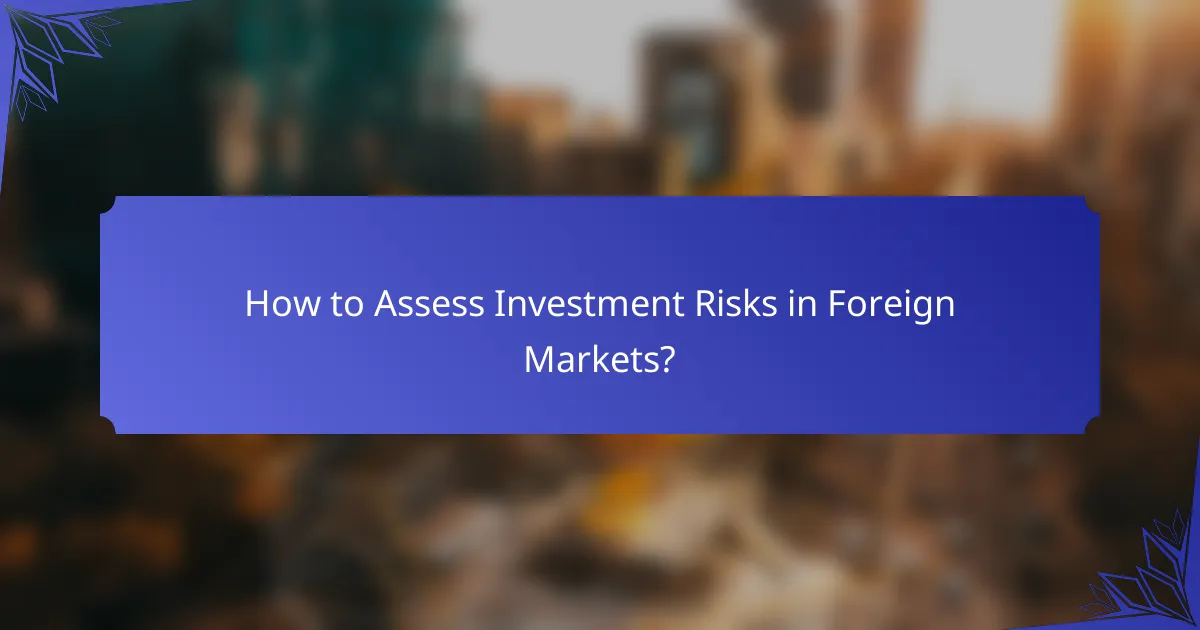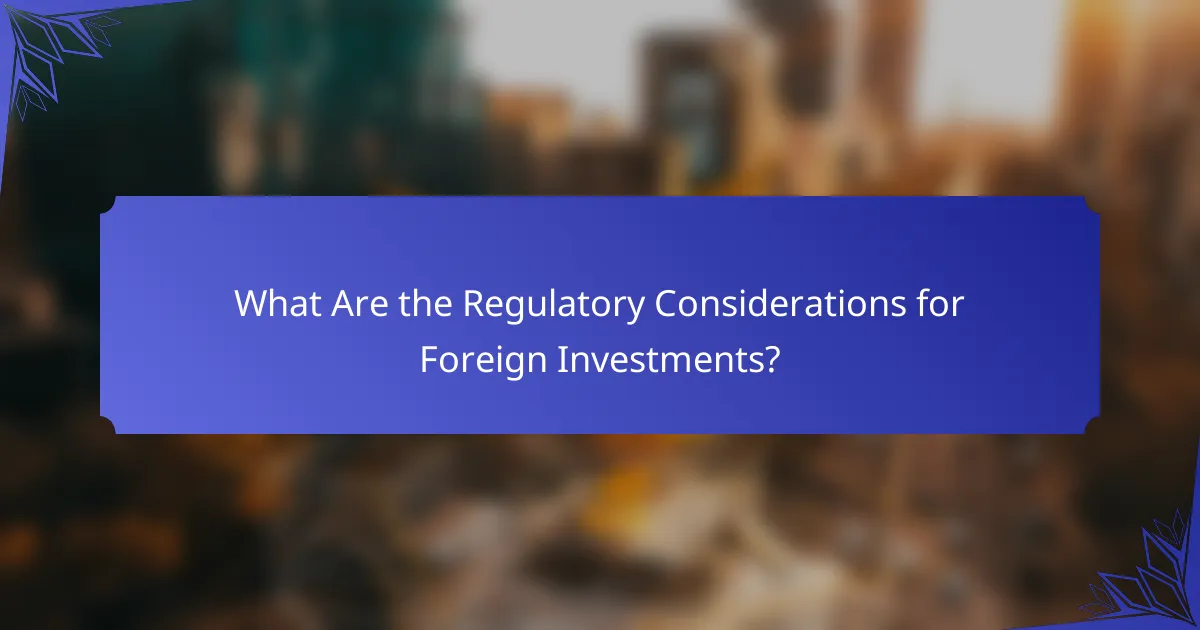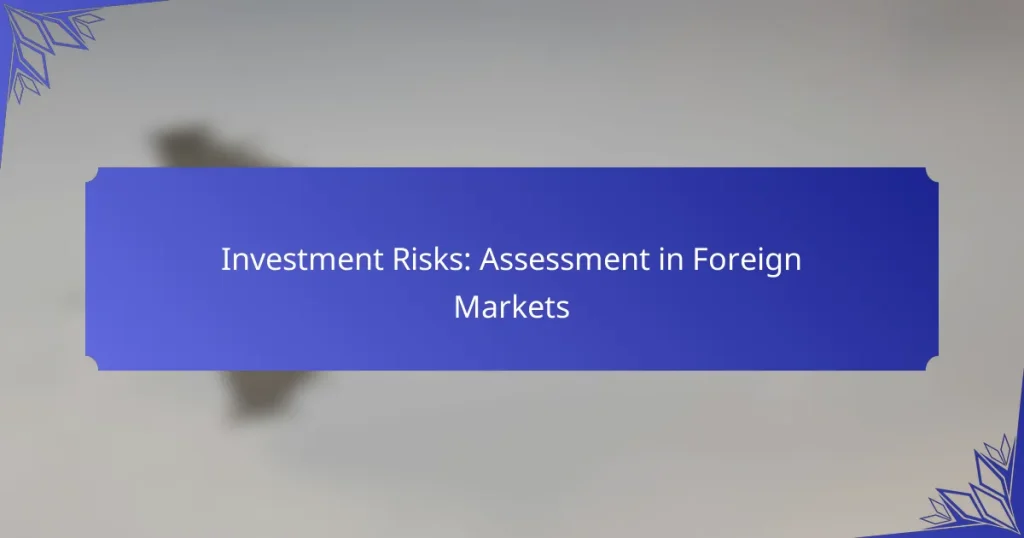Investing in foreign markets presents unique risks that can greatly affect potential returns. Understanding factors such as political instability, currency fluctuations, and local regulatory environments is crucial for effective risk assessment. By employing comprehensive market research and strategic partnerships, investors can better navigate these challenges and enhance their investment outcomes.

What Are the Key Investment Risks in Foreign Markets?
Investing in foreign markets involves various risks that can significantly impact returns. Key risks include political instability, currency fluctuations, regulatory changes, market volatility, and economic downturns.
Political instability
Political instability refers to the likelihood of government changes, civil unrest, or conflict that can disrupt economic activities. Investors should assess the political climate of a country before committing capital, as instability can lead to sudden losses.
For example, countries experiencing frequent protests or changes in leadership may pose higher risks. Monitoring news and political analysis can help gauge the stability of a region.
Currency fluctuations
Currency fluctuations can affect the value of investments when converting profits back to the investor’s home currency. Changes in exchange rates can lead to unexpected gains or losses, impacting overall returns.
Investors should consider hedging strategies to mitigate this risk, such as using forward contracts or options. Understanding the currency trends of the target market is essential for effective risk management.
Regulatory changes
Regulatory changes can alter the business landscape, affecting everything from taxation to operational requirements. New laws or amendments can create barriers or opportunities for foreign investors.
Staying informed about local regulations and compliance requirements is crucial. Engaging with local legal experts can provide insights into potential regulatory shifts that may impact investments.
Market volatility
Market volatility refers to the degree of variation in trading prices over time. Foreign markets can experience higher volatility due to factors like economic events, geopolitical tensions, or changes in investor sentiment.
Investors should be prepared for price swings and consider diversifying their portfolios to manage this risk. Utilizing stop-loss orders can also help limit potential losses during volatile periods.
Economic downturns
Economic downturns can lead to reduced consumer spending, lower corporate profits, and overall market decline. Foreign markets may be more susceptible to global economic shifts, impacting investment performance.
Investors should analyze economic indicators such as GDP growth, unemployment rates, and inflation before entering a foreign market. Being aware of economic cycles can help in making informed investment decisions.

How to Assess Investment Risks in Foreign Markets?
Assessing investment risks in foreign markets involves understanding local economic conditions, regulatory environments, and cultural factors that may impact returns. A comprehensive approach includes market research, risk assessment tools, and insights from local experts.
Conduct thorough market research
Market research is essential for identifying potential risks in foreign investments. This includes analyzing economic indicators, political stability, and market trends specific to the country of interest. For instance, understanding currency fluctuations and inflation rates can help gauge the financial health of the market.
Utilize resources such as government publications, financial reports, and market analysis from reputable firms. Engaging with local news sources can also provide timely insights into emerging risks or opportunities.
Utilize risk assessment tools
Risk assessment tools can help quantify potential risks associated with foreign investments. Tools like SWOT analysis (Strengths, Weaknesses, Opportunities, Threats) and scenario analysis allow investors to evaluate different outcomes based on varying market conditions.
Consider using software solutions that specialize in risk management, which can provide simulations and forecasts based on historical data. This can aid in making informed decisions about where to allocate resources and how much to invest.
Engage local experts
Local experts can offer invaluable insights into the nuances of foreign markets. This includes understanding regulatory requirements, cultural attitudes toward business, and local consumer behavior. Building relationships with local consultants or financial advisors can enhance your investment strategy.
Attend industry conferences or networking events in the target country to connect with professionals who have firsthand experience. Their knowledge can help you avoid common pitfalls and identify unique opportunities that may not be apparent through research alone.

What Strategies Mitigate Investment Risks Abroad?
To effectively mitigate investment risks abroad, employing a combination of strategies is essential. These strategies include diversifying investments, hedging against currency fluctuations, and establishing local partnerships to navigate foreign markets more effectively.
Diversification of investments
Diversification involves spreading investments across various asset classes, sectors, and geographic regions to reduce risk. By not putting all your capital into a single investment, you can protect yourself from significant losses if one area underperforms.
For example, an investor might allocate funds across stocks, bonds, real estate, and commodities in different countries. This approach can help balance potential gains and losses, especially in volatile markets.
Hedging against currency risk
Hedging against currency risk is crucial when investing in foreign markets, as exchange rate fluctuations can significantly impact returns. Investors can use financial instruments like options and futures to lock in exchange rates or consider currency-hedged funds.
For instance, if an American investor buys European stocks, they may use currency futures to protect against the euro depreciating against the dollar. This strategy helps ensure that currency movements do not erode investment gains.
Establishing local partnerships
Forming partnerships with local firms can provide valuable insights into the market and regulatory landscape. Local partners often have a better understanding of consumer behavior, legal requirements, and potential risks, which can enhance decision-making.
For example, a U.S. company entering the Asian market might collaborate with a local distributor to navigate cultural nuances and distribution channels effectively. This collaboration can lead to more successful market penetration and reduced operational risks.

What Are the Regulatory Considerations for Foreign Investments?
Regulatory considerations for foreign investments involve understanding the legal frameworks and compliance requirements of the host country. Investors must navigate local laws and international regulations to mitigate risks and ensure successful investment outcomes.
Understanding local laws
Local laws govern various aspects of foreign investments, including ownership restrictions, taxation, and operational regulations. Each country has its own set of rules that can significantly impact investment strategies. For example, some nations may require foreign businesses to partner with local entities or limit foreign ownership to a certain percentage.
Investors should conduct thorough due diligence to understand these laws, as non-compliance can lead to penalties or even the loss of investment. Engaging local legal experts can provide valuable insights into the regulatory landscape and help navigate complex legal requirements.
Compliance with international regulations
In addition to local laws, foreign investors must comply with international regulations that may apply to their investments. This includes adhering to guidelines set by organizations such as the OECD or the World Bank, which promote fair practices and transparency. Compliance with these standards can enhance an investor’s reputation and facilitate smoother operations across borders.
It is crucial to stay informed about changes in international regulations, as they can affect investment viability and risk exposure. Regularly reviewing compliance requirements and seeking advice from international legal experts can help investors avoid pitfalls associated with regulatory non-compliance.

How Do Economic Indicators Affect Foreign Investment Risks?
Economic indicators significantly influence foreign investment risks by providing insights into a country’s financial health and stability. Investors closely monitor these indicators to assess potential returns and the likelihood of adverse conditions that could impact their investments.
Impact of GDP growth rates
GDP growth rates are crucial for evaluating foreign investment risks, as they reflect a country’s economic performance. A consistently high GDP growth rate often signals a robust economy, attracting foreign investors seeking growth opportunities.
Conversely, declining or stagnant GDP growth can indicate economic troubles, leading to increased investment risks. Investors should consider GDP trends over several quarters or years to gauge long-term stability rather than relying on short-term fluctuations.
Inflation rates as risk factors
Inflation rates are a key risk factor for foreign investments, as they affect purchasing power and overall economic stability. High inflation can erode returns on investment, making it essential for investors to monitor inflation trends in their target markets.
Investors should be cautious in countries with rising inflation rates, as this can lead to increased costs and reduced consumer spending. A practical approach is to compare inflation rates with those of neighboring countries or regional averages to assess relative risk levels.


